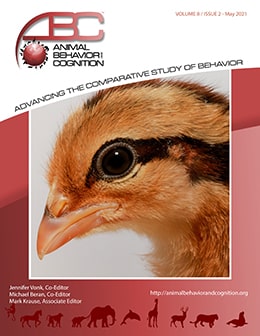Vol 8, Issue 2, May 2021
Bending and Unbending of Tools by New Caledonian Crows (Corvus Moneduloides) in a Problem-Solving Context
Citation
van Buuren, M., Alfredsson, J., Mioduszewska, B., Tebbich, S, & von Bayern, A.M.P. (2021). Bending and unbending of tools by New Caledonian crows (Corvus moneduloides) in a problem-solving context. Animal Behavior and Cognition, 8(2), 190-215. https://doi.org/10.26451/abc.08.02.07.2021
Abstract
New Caledonian crows (NCCs) are proficient tool manufacturers and flexible problem solvers. A study reporting innovative hook bending by a captive individual in 2002 (Weir et al., 2002), has since been cited as a remarkable case of causal reasoning in animals. Recently, however, tool bending has been found to form part of the species’ natural behavioral repertoire. Yet, further studies examining the flexibility of this behavior in controlled novel problem-solving contexts are lacking. We tested 17 captive NCCs, in one tool bending and three unbending problem-solving experiments. In the first study, two groups of five subjects were trained to select inflexible straight or hooked tools respectively for retrieving food from an apparatus. In the subsequent test, the crows were supplied with the wrong, but now pliable, type of tool. Three subjects made hooks while one subject straightened tools consistently. In the second study, 13 subjects, including five from Study 1, were tested. Ten subjects received an unbending task with a Z-shaped tool without prior training. Both angles needed to be straightened for the tool to become sufficiently long for reward retrieval. Four subjects solved the task at least once, and two did so consistently. Eight subjects, including the previous solvers, were challenged with yet another apparatus, requiring novel unbending behavior. One crow succeeded in both unbending tasks consistently. Our results show that NCCs can flexibly bend or unbend pliant material to create tools for solving novel tasks. The underlying cognitive mechanisms seemingly varied across individuals although trial-and-error learning prevailed.
Keywords
New Caledonian crows, Tool manufacture, Innovation, Novel problem solving, Bending, Unbending, Trial-and-error learning
